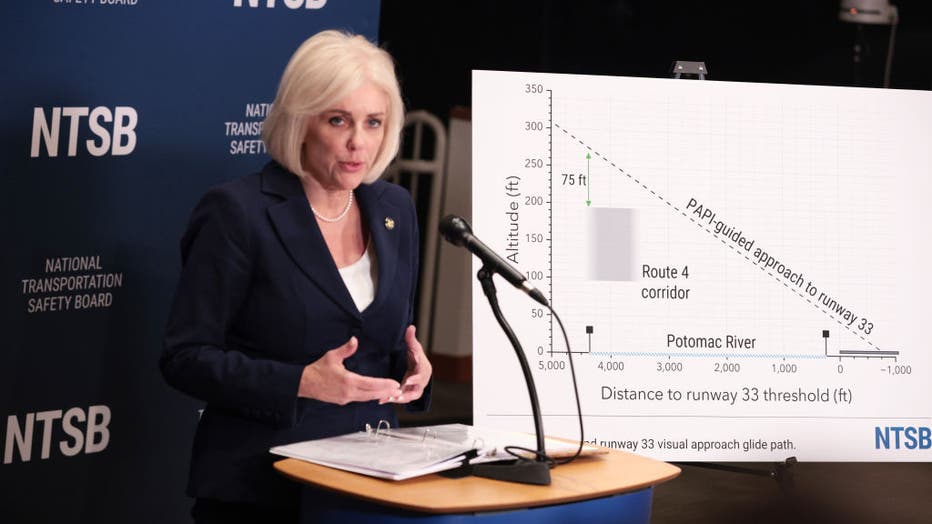DCA plane crash: investigators push for stricter helicopter rules

NTSB releases preliminary report on DCA plane crash
Federal investigators probing the deadly January crash between a passenger jet and an Army helicopter over the Potomac River are calling for a ban on certain helicopter flights, saying the current rules are too dangerous. FOX 5's Shirin Rajaee has the latest details.
WASHINGTON - Federal investigators probing the deadly January crash between a passenger jet and an Army helicopter over the Potomac River are calling for a ban on certain helicopter flights, saying the current rules are too dangerous.
The crash killed 67 people.
The collision occurred as the American Airlines jet was approaching Ronald Reagan National Airport on Jan. 29. Among the victims were 28 members of the figure skating community.
DCA crash sparks safety warning
What they're saying:
National Transportation Safety Board Chairwoman Jennifer Homendy said the board determined that the existing separation distance between planes and helicopters at Reagan National Airport is "insufficient and poses an intolerable risk to aviation safety."
Homendy said she was angry and also devastated for families that are grieving because they lost loved ones.
"It shouldn’t take tragedy to require immediate action," she said.
Under the current practice, helicopters and planes can be as close as 75 feet apart from each other during landing, Homendy said. Investigators have identified 15,214 instances of planes getting alerts about helicopters being in close proximity between October 2021 and December 2024, she said.
Following the crash, the FAA took steps to restrict helicopter flights around Reagan National Airport to ensure that planes and helicopters are no longer sharing the same airspace. Now flights are put on hold temporarily when helicopters need to pass by the airport.
Investigators call for helicopter ban
Big picture view:
Homendy said the NTSB is recommending that the FAA find a "permanent solution" for alternate routes for helicopter traffic when two of the airport’s runways are in use.
Investigators have said the helicopter may have had inaccurate altitude readings in the moments before the crash, and the crew may not have heard key instructions from air traffic controllers. The collision likely occurred at an altitude just under 300 feet (91 meters), as the plane descended toward the helicopter, which was well above its 200-foot (61-meter) limit for that location.

WASHINGTON, DC - MARCH 11: Chair of the National Transportation Safety Board (NTSB) Jennifer Homendy speaks during a news conference at the headquarters of NTSB on March 11, 2025 in Washington, DC. The NTSB released a report urging the FAA to take im
The helicopter pilots may have also missed part of another communication, when the tower said the jet was turning toward a different runway, Homendy said last month.
The helicopter was on a "check" flight that night where the pilot was undergoing an annual test and a test on using night vision goggles, Homendy said. Investigators believe the crew was wearing night vision goggles throughout the flight.
The Army has said the Black Hawk crew was highly experienced, and accustomed to the crowded skies around the nation’s capital.

DCA plane crash: Victim's family files $250M claim
The family of Casey Crafton, a victim of the Potomac aviation crash, has filed a $250 million claim against the U.S. Army and FAA, alleging negligence. FOX 5's Shirin Rajaee has the story.
Within just a month’s time earlier this year, there were four major aviation disasters in North America, including the midair collision over the Potomac and most recently in mid-February when a Delta flight flipped and landed on its roof at Toronto’s Pearson Airport, injuring 21 people.
Those accidents and close calls left some worried about the safety of flying even though fatal crashes are rare and the track record of U.S. airlines is remarkably sound.
President Donald Trump blamed the midair collision over Washington, D.C., on what he called an "obsolete" air traffic control system and promised to replace it. He also faulted the helicopter for flying too high.
Federal officials have been raising concerns about an overtaxed and understaffed air traffic control system for years, especially after a series of close calls between planes at U.S. airports. Among the reasons they have cited for staffing shortages are uncompetitive pay, long shifts, intensive training and mandatory retirements.
Watch the full NTSB press conference below:

NTSB delivers DCA plane crash updates
Federal investigators probing the deadly January crash between a passenger jet and an Army helicopter over the Potomac River are calling for a ban on certain helicopter flights, saying the current rules are too dangerous.
The Source: The Associated Press contributed to this report.



